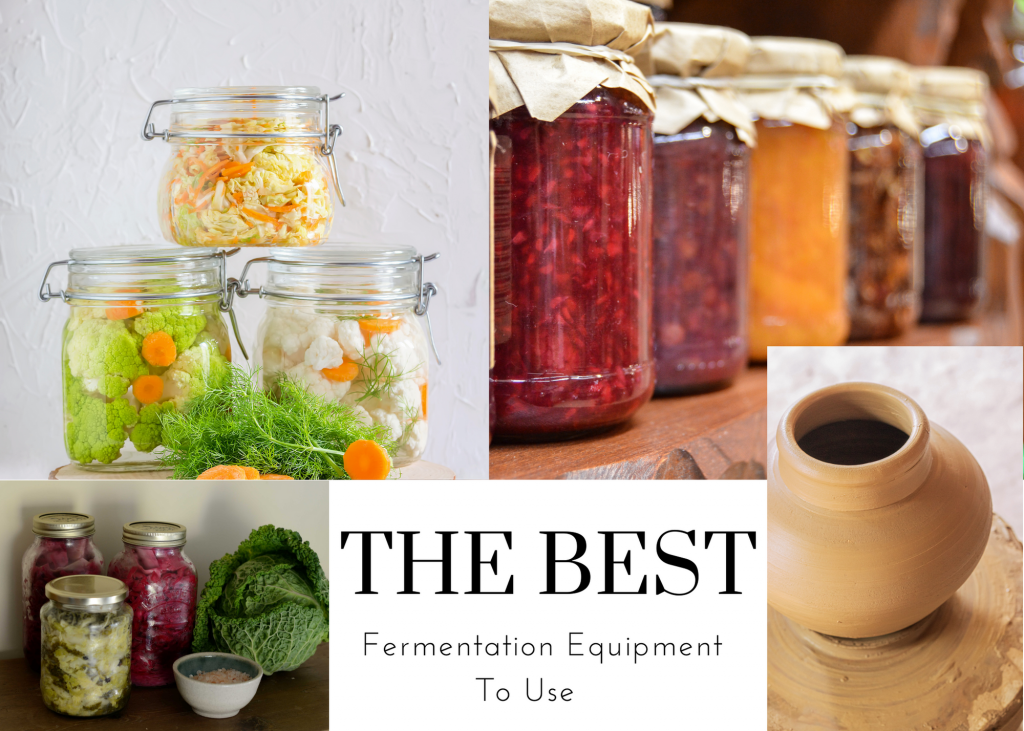
This is one of the most confusing and controversial topics out there…what is the best fermenting equipment to use? And yet it seems like it should be the easiest topic to provide an answer for. When I started writing on this subject, I quickly found myself going down several rabbit holes. In my post “The Importance of Time Tested Fermenting Equipment,” we tackled the historical perspective on fermentation equipment. This is in effect, a “sequel” if you will, to that post. So let’s see what we can glean from that post and how that helps us decide the best fermenting equipment to use today!
Summary of Historical Fermenting Equipment
I do need to give a quick summary of my post on historical fermenting equipment. This will set the stage for our discussion.
History shows us that people understood what worked in order to preserve their food into the next season and beyond (in the case of a draught). I will list out the methods we went over in the previous post. This will give us a snapshot of many (but not all) of the traditional methods used for fermenting.

- Calabash Gourd
- Animal Skins
- Fermenting Pit
- Pottery Jars
- Earthenware
Bridging the Gap
All of these methods have been time tested and they all have one thing in common. Each method results in an anaerobic (no-oxygen) environment. However, I’m thinking most of us won’t be, for instance, digging a pit in our back yard to ferment possibly hundreds of pounds of food. The difficult part about utilizing these techniques today is that for a lot of us in the modernized world, many of the options we’ve talked about are not practical. Most of us don’t have room for a few giant pottery vessels to hold a years worth of sauerkraut. And using a gourd? I had never even heard of calabash gourds until researching traditional fermenting vessels.
That’s where smaller scale containers have stepped in the gap, so to speak. Containers similar to the harsch crock, the bormioli rocco fido jar with an airlock, the mason jar, and open containers. The question we need to ask is, are all these containers equivalent and equally effective?
Open Air Fermenting Equipment
In my post, the science behind fermentation and it’s benefits, I go into detail about what fermentation is and how it occurs. Here is a short recap.
Lactic acid bacteria, which predominantly causes fermentation, requires an anaerobic environment. If you are using an open air system with just a cloth or plate over the covering, the microbes predominating your “ferment” will be oxygen loving (i.e. mold). Those microbes bring on the decay of your food much faster, and don’t have the nutritional benefit that lactic acid bacteria does.
In this research article, the effects of oxygen exposure on white radish being fermented are looked at. As you can see from the picture below, the radish in the second and fourth rows are in the water lock container. They do not produce any film on the top or mold, and the radish retains it’s texture and pectin. The radish exposed to oxygen (first and third rows) quickly gets that film on the top, and later produces mold. The pectin in the vegetable decreases, the vegetables get soft and the cell walls are damaged.
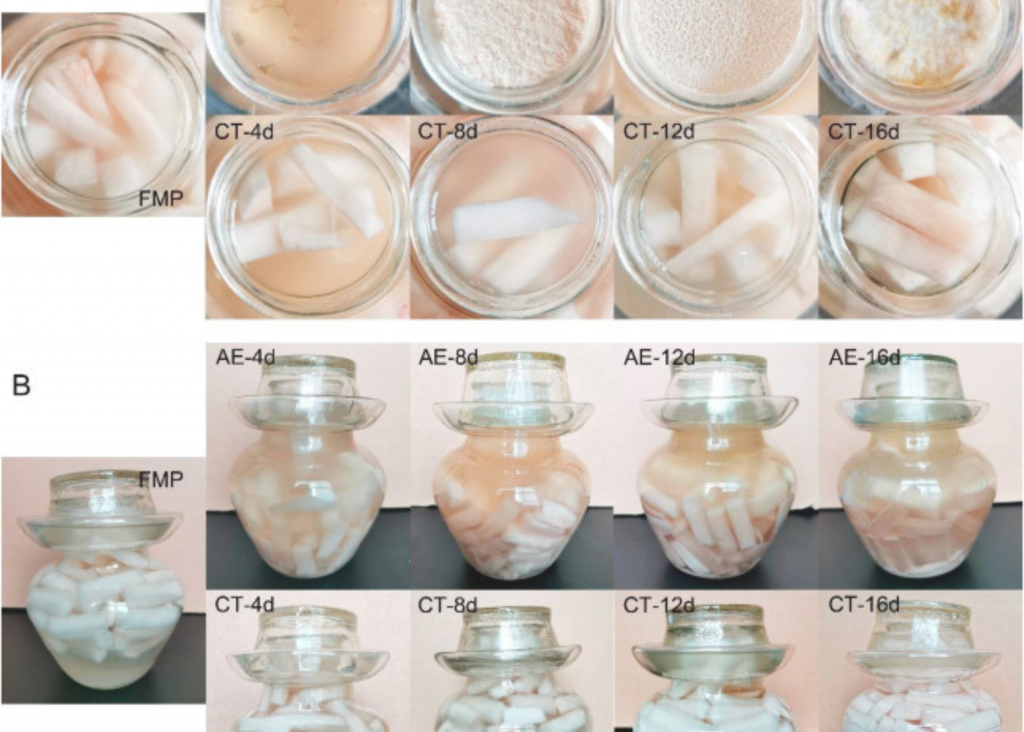
My conclusion then, is that open air fermenting does not allow beneficial fermentation processes to occur, but rather is a conduit for food decay.
Mason Jar Fermenting Equipment
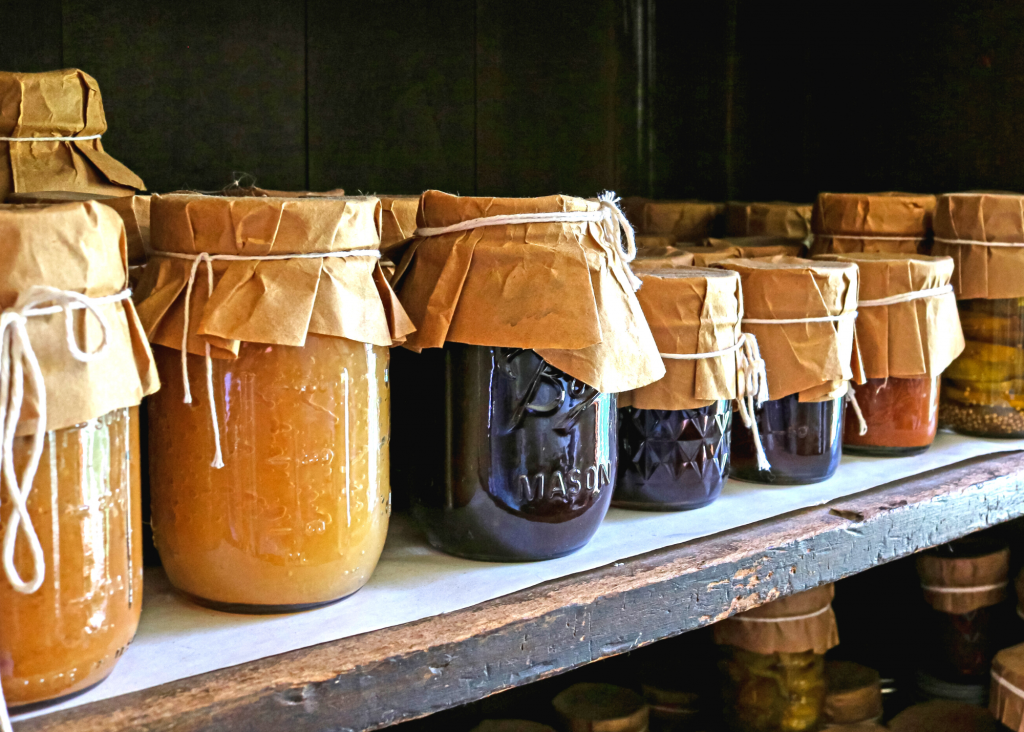
The next question would be, which category do mason jars fit under? I have seen many modifications to the mason jar system.
- First, a cloth covering (which would fit under the open air fermentation category)
- Second, just a regular metal or plastic lid
- Third, a special lid with the equipment to vacuum out the oxygen
- Fourth, some type of lid modification with an airlock in place
Obviously the first example listed is under the open air fermenting category.
The second through fourth categories I would still consider unable to reach an anaerobic fermenting stage. I will briefly touch on some of the issues I see with these set-ups. However, in order to do justice to this topic, I will go more in depth on mason jar modifications in another post.
Concerns with Mason Jar Fermenting Equipment
In general, having some kind of lid is better that an open air system, but it is not actually airtight. It has more to do with the mechanism of the lid style than with any lid modifications. The manner of screwing a lid down will never produce enough downward force to keep oxygen out.
In the directions for preparing mason jars for canning, it states that high heat is needed to remove all the oxygen. Best practice is to take the ring off after canning is complete. So the screwing mechanism isn’t enough to seal it completely or in a long term fashion. Remember that our goal to achieve authentic fermentation is an anaerobic environment. Even a little oxygen seeping in will spoil your ferment, or at the least result in an inferior end result.
Something else to consider; although mason jars are much more economical, that means you get what you pay for. The glass is thinner and doesn’t hold up well under any pressure that might build up. Some brands of mason jars can be made from inferior materials. This means whatever the glass (or lid) is made of can be leached into your ferment (due to the high acidic nature of fermenting). If we are talking heavy metals or plastics, that’s not something healthy to be ingesting.
Side Note on Plastics
I feel like I shouldn’t even have to talk about fermenting in plastic containers, but to be thorough, let’s talk. As most of us have heard over the years, BPA is present in many common plastics that we use every day. Why is this concerning? Many plastics have what’s called estrogenic activity. This means that it can negatively effect the hormones in your body, leading to a host of severe health problems. This research article looks at common plastics labeled as BPA free and assesses whether they have estrogenic activity. The results? Almost everything that was tested, even if it was labeled as BPA free, had leached chemicals with clear evidence of estrogenic activity. Highly acidic foods will leach whatever is possible from the environment, including the container. I’d advise steering clear of plastics altogether.
Conclusion on Mason Jar Fermenting Equipment
My conclusion about mason jars is that they just don’t hold up to the requirements for creating that anaerobic environment. Again, there are many different avenues for discussion regarding the mason jar and other fermenting styles. Continue the discussion in this post.
Water-lock Crock and Swing-top Jar Fermenting Equipment
These two categories I would consider equivalent. Both have enough pressure to seal the top on. The water-lock crock has the weight of the lid, and the swing-top has the pressure of the wire bails. In addition, they both utilize a water lock to create a seal which allows gasses and oxygen out, but nothing in. Thus we have a recreation of the traditional anaerobic fermenting vessel.
Crock
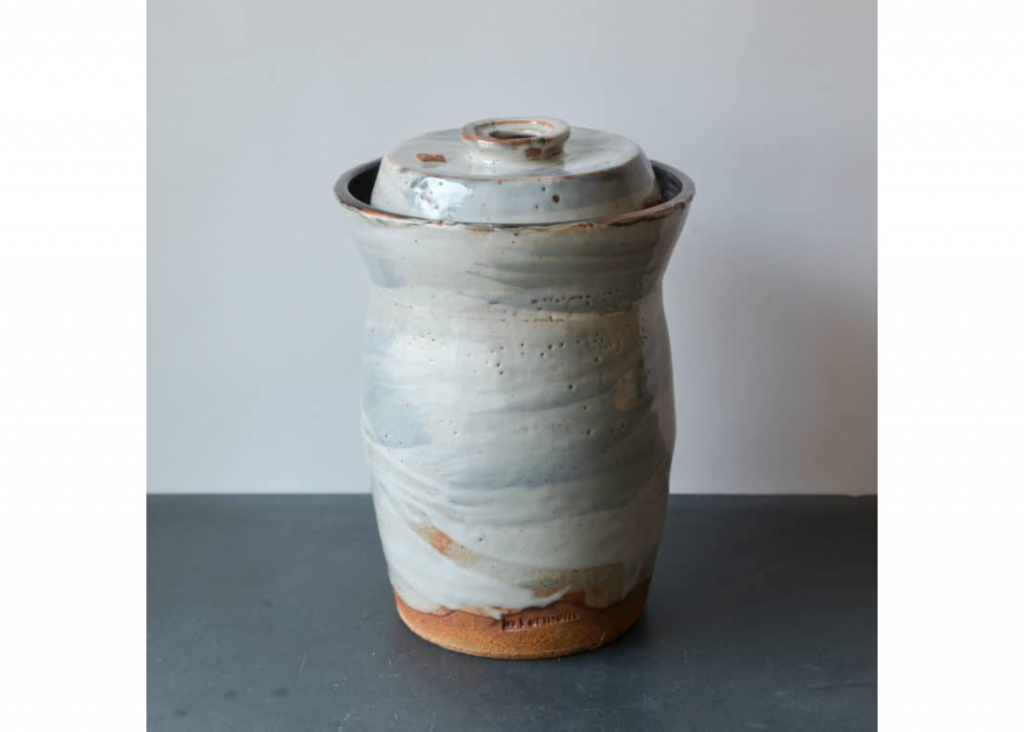
The benefit of a crock is their large size for fermenting a decent quantity of food at once. Plus, the container has the ability to maintain a somewhat consistent temperature. And since it is not transparent, the environment stays nice and dark for the bacteria.
The downsize is…their size. And weight. These days you can find ones that are smaller (1.5L), but another aspect to these fermenting vessels is that they are spendy. It’s worth it to buy a larger one. However, then you need to address the space issue. If you’re short on space or don’t have a cool enough area to store them in, it’s not a good option. Also, going back to transparency, since they are made of a non-transparent material, you can’t monitor your ferment as easily.
Fido Jar with Airlock
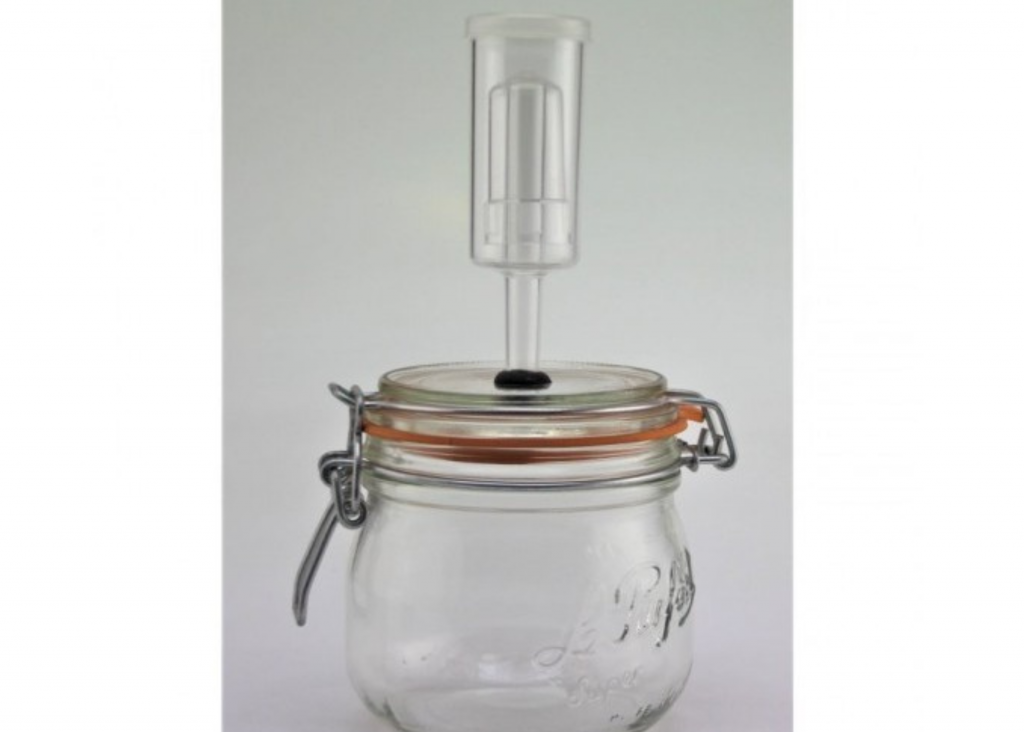
The swing-top, or fido jar, has the benefit of a smaller size (up to a 5L) and the ability to monitor your ferment due to the see through glass. It can’t hold a consistent temperature however, so storing properly is a must. Buying just one or two won’t break the bank, and it is fairly easy to rotate through several short term ferments utilizing a few jars and other means of preserving, like dehydrating and/or freezing. However, if you are looking for preservation fermenting, you will need several, and that can get expensive.
Conclusion for Crock and Swing-top Fermenting Equipment
As you can already tell, these two fermenting equipment styles meet the requirements for that anaerobic fermenting environment. The key here is having a vessel that will close thoroughly and not allow anything in. But in order to avoid the dreaded fermentation explosion, it needs to allow those gasses to escape as well.
The Best Fermenting Equipment Is…?
As you can see, there are negatives and positives for each fermenting style and equipment. Although in my opinion some have only negatives to bring forth. With that being said, ultimately the person who will care the most about your health is you.
I feel I’ve given a good, well thought out and researched case for what type of fermenting equipment is best to use. However, I do acknowledge that some people might come to a different conclusion. It is paramount that you do your own research and be well informed. Then you can make the decision that you are most comfortable with and which is best for your health.
Personal Experience
I have used the fido jars with an airlock for years now, and have never had a mold growth issue or good quality produce go bad. My family has never gotten sick from eating our fermented foods and we rarely get sick in general. I’m sure there are plenty of other factors working towards that, but I believe fermented foods have played a large role in our health.
When I first started fermenting, I had 3-4 jars. I just rotated through the quick ferments and whatever we didn’t eat I froze or dehydrated. That way I had a continuous supply of fermented foods and their health benefits while I was able to build up my supply of jars. And I’ve always found it a fun puzzle to try and figure out what I should ferment next, which food needs to go in what jar and how to make it work the most efficiently.
I hope this has helped you get an overview of the importance of the fermenting method/equipment options. Whatever you decide to use, please continue to learn more about the fascinating world of fermentation here at Healthy Joyous Living, and try out some of the recipes coming soon!


Leave a Reply